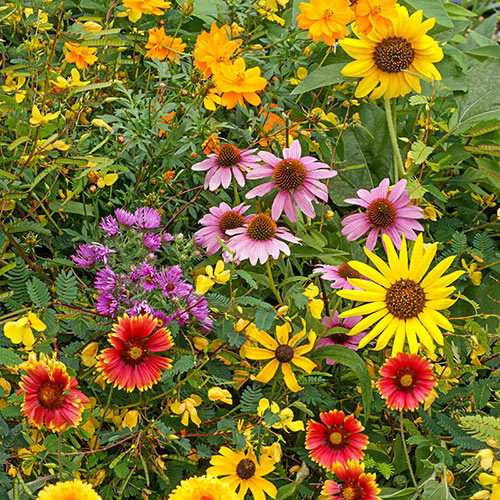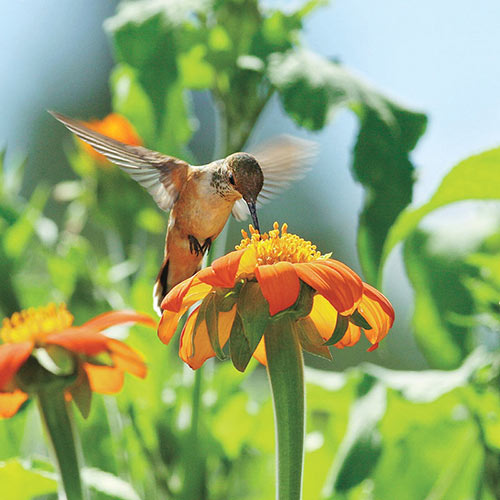These Plants Are for the Birds!
-
Helpful Products from Gardens Alive!
-
 Bird Lovers Seed Mix
Bird Lovers Seed Mix -
 Mexican Sunflower
Mexican Sunflower -
 Marigold Inca II Seed Mix
Marigold Inca II Seed Mix
Q. Nicole from Wilmington North Carolina writes: "Hey Mike! I enjoy listening to your podcast!" {McG: Sigh. I guess that means we HAVE to use your question now, doesn't it?}
"I recently moved to the Wilmington area (Zone 8) and can't wait to start landscaping! I'm placing my left-over cardboard moving boxes in strategic locations in my backyard to map out where I think I'll put raised garden beds. I'm hoping that having them there for a few months before I put the my raised beds in place will kill some of the grass, AND I can watch the sun's movements over time to make sure it's an optimal location."
{Interrupting McG: That last part is a GREAT idea. Many people give no thought to the movement of the sun over the season, and you'll have the real-life data to make an informed decision. Unless you ignore it, of course...}
Back to Nicole: "My backyard will be dedicated to food gardening. My thoughts for the front yard are to make an area for the birds and bees! I have room for about three trees, a few shrubs and, I hope, lots of perennial flowers. I want to try and feed the birds with the trees. I learned from you that bird seed feeders are not always a good thing for the birds, and I am trying to break my bad bird feeding habit! The internet told me that birds like to eat mulberry and crab apple; and these trees will not be around driveways or cars so if they get a little messy I'm ok with that.
What are your top choices of trees and shrubs to feed the birds?"
A. I can tell you from personal experience that birds love to eat crab apples in the fall, after the fruits have fermented on the tree. The first year I lived here, I started to notice what looked like tomato sauce on my car every morning. "Lousy kids", I thought, "leave my last tomatoes alone!" Then one morning an obviously poop-faced drunken robin kind of fell on my windshield. He didn't crash; he kind of bird-stumbled onto the car, looked over at me and seemed to say, 'scuse me, sir; rest assured this won't happen again". Then he rolled over a couple dozen times to get his footing, took off and fell into the hardy begonias. I think he was laughing.
In other words, you'd be running the local Titmouse Taproom as opposed to a Rockin' Robin restaurant. And this tree is NOT a four-season delight. For about three weeks in the Spring (especially if the weather is dry), it sports bright red flower buds that open to pink and finally decorate a huge area around the tree with white flower petals ("Hey! Anybody wanna get married before it rains?!")
The rest of the year, people look at it and ask, 'is it dead?" To which I am morally obligated to say, "NO! It's just restin!" However, I must admit that it also attracts an almost impossible number of bumblebees when it blooms, which I consider essential as little else is in flower that early in the season and the bumbles are already out and hungry. Let's just agree that it isn't a showcase tree; OK?"
Mulberries? Where were you searching? "Gardens of the damned?!" At any rate, this complicated sidewalk stainer deserves its own article and it shall receive one. Maybe soon!
And now, back to our show in progress (yes; he's finally going to answer the question, kats and kittens!!) Back in '93, we did a special issue of ORGANIC GARDENING magazine featuring the most carnivorous birds and the plants that they love. Here's what we came up with:
#1: Pines. (Surprised? So was I!) But native pines attract beneficial birds all year long, with shelter, pinecone seeds and bark insects. Among the visiting birdies are cardinals, chickadees, flycatchers, nuthatches, vireos and many more.
#2: Junipers. They will bring you cardinals, grosbeaks, phoebes and robins.
#3. Serviceberries. An EXCEPTIONAL plant that pollinates and fruits very early in the season, producing 'our' first human fruits ("June berries"). Attracts a massive number of pollinators and beneficial birds.
#4: Hollies. To get the best fruit, make sure the plant has a pollinator if it needs one. (Then you also got pollinator plants!) Provides welcome food and shelter in the winter for cardinals, jays, cedar waxwings and many others. (Yes. That's four and not three; I make the rules here in Mike's Multiverse! And besides, we're not done yet!)
Native ornamental grasses; provide food and shelter from late summer through winter for a wide variety of seed eaters. Noted naturalist Craig Tufts of the National Wildlife Foundation recommends bluestem and "Indian grass" but turns the thumb down to invasive pest grasses like pampas and miscanthus, which are becoming a real problem in certain areas.
Annual flowers: SENSATION Cosmos (sets a lot of seed over a long period of time); amaranth, Bachelor's Button, calendula; coreopsis, marigolds; Mexican Sunflower (Tithonia; one of our personal faves; fattens up the monarch butterflies for their long migration in the Fall!); nasturtiums; snapdragons; sweet alyssum and Zinnia.
Perennials: coreopsis; foxglove (don't let kids near it and always wear gloves handling it); purple coneflower (echinacea); California poppy; gloriosa daisy; and goldenrod.
"I recently moved to the Wilmington area (Zone 8) and can't wait to start landscaping! I'm placing my left-over cardboard moving boxes in strategic locations in my backyard to map out where I think I'll put raised garden beds. I'm hoping that having them there for a few months before I put the my raised beds in place will kill some of the grass, AND I can watch the sun's movements over time to make sure it's an optimal location."
{Interrupting McG: That last part is a GREAT idea. Many people give no thought to the movement of the sun over the season, and you'll have the real-life data to make an informed decision. Unless you ignore it, of course...}
Back to Nicole: "My backyard will be dedicated to food gardening. My thoughts for the front yard are to make an area for the birds and bees! I have room for about three trees, a few shrubs and, I hope, lots of perennial flowers. I want to try and feed the birds with the trees. I learned from you that bird seed feeders are not always a good thing for the birds, and I am trying to break my bad bird feeding habit! The internet told me that birds like to eat mulberry and crab apple; and these trees will not be around driveways or cars so if they get a little messy I'm ok with that.
What are your top choices of trees and shrubs to feed the birds?"
A. I can tell you from personal experience that birds love to eat crab apples in the fall, after the fruits have fermented on the tree. The first year I lived here, I started to notice what looked like tomato sauce on my car every morning. "Lousy kids", I thought, "leave my last tomatoes alone!" Then one morning an obviously poop-faced drunken robin kind of fell on my windshield. He didn't crash; he kind of bird-stumbled onto the car, looked over at me and seemed to say, 'scuse me, sir; rest assured this won't happen again". Then he rolled over a couple dozen times to get his footing, took off and fell into the hardy begonias. I think he was laughing.
In other words, you'd be running the local Titmouse Taproom as opposed to a Rockin' Robin restaurant. And this tree is NOT a four-season delight. For about three weeks in the Spring (especially if the weather is dry), it sports bright red flower buds that open to pink and finally decorate a huge area around the tree with white flower petals ("Hey! Anybody wanna get married before it rains?!")
The rest of the year, people look at it and ask, 'is it dead?" To which I am morally obligated to say, "NO! It's just restin!" However, I must admit that it also attracts an almost impossible number of bumblebees when it blooms, which I consider essential as little else is in flower that early in the season and the bumbles are already out and hungry. Let's just agree that it isn't a showcase tree; OK?"
Mulberries? Where were you searching? "Gardens of the damned?!" At any rate, this complicated sidewalk stainer deserves its own article and it shall receive one. Maybe soon!
And now, back to our show in progress (yes; he's finally going to answer the question, kats and kittens!!) Back in '93, we did a special issue of ORGANIC GARDENING magazine featuring the most carnivorous birds and the plants that they love. Here's what we came up with:
#1: Pines. (Surprised? So was I!) But native pines attract beneficial birds all year long, with shelter, pinecone seeds and bark insects. Among the visiting birdies are cardinals, chickadees, flycatchers, nuthatches, vireos and many more.
#2: Junipers. They will bring you cardinals, grosbeaks, phoebes and robins.
#3. Serviceberries. An EXCEPTIONAL plant that pollinates and fruits very early in the season, producing 'our' first human fruits ("June berries"). Attracts a massive number of pollinators and beneficial birds.
#4: Hollies. To get the best fruit, make sure the plant has a pollinator if it needs one. (Then you also got pollinator plants!) Provides welcome food and shelter in the winter for cardinals, jays, cedar waxwings and many others. (Yes. That's four and not three; I make the rules here in Mike's Multiverse! And besides, we're not done yet!)
Native ornamental grasses; provide food and shelter from late summer through winter for a wide variety of seed eaters. Noted naturalist Craig Tufts of the National Wildlife Foundation recommends bluestem and "Indian grass" but turns the thumb down to invasive pest grasses like pampas and miscanthus, which are becoming a real problem in certain areas.
Annual flowers: SENSATION Cosmos (sets a lot of seed over a long period of time); amaranth, Bachelor's Button, calendula; coreopsis, marigolds; Mexican Sunflower (Tithonia; one of our personal faves; fattens up the monarch butterflies for their long migration in the Fall!); nasturtiums; snapdragons; sweet alyssum and Zinnia.
Perennials: coreopsis; foxglove (don't let kids near it and always wear gloves handling it); purple coneflower (echinacea); California poppy; gloriosa daisy; and goldenrod.
-
Helpful Products from Gardens Alive!
-
 Bird Lovers Seed Mix
Bird Lovers Seed Mix -
 Mexican Sunflower
Mexican Sunflower -
 Marigold Inca II Seed Mix
Marigold Inca II Seed Mix







 Gardens Alive! & Supplies
Gardens Alive! & Supplies




